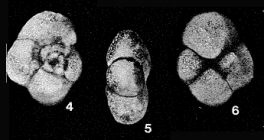Foraminifera taxon details
Bagginoides Podobina, 1975 †
722325 (urn:lsid:marinespecies.org:taxname:722325)
accepted
Genus
Discorbis quadrilobus Mello, 1969 † accepted as Bagginoides quadrilobus (Mello, 1969) † (type by original designation)
marine, brackish, fresh, terrestrial
fossil only
masculine
Podobina, V. M. (1975). Фораминиферы верхнего мела и палеогена Западно-Сибирской низменности, их значение для стратиграфии - Foraminifera of the Upper Cretaceous and Paleogene from the West Siberian depression, their importance for stratigraphy. <em>Томск, изд-во Томского ун-та - Tomsk University Press.</em> 1-290., available online at http://www.geokniga.org/bookfiles/geokniga-podobina-1975-foram.pdf
page(s): p. 101 [details] Available for editors [request]
[request]
page(s): p. 101 [details] Available for editors
Diagnosis Test small, up to 0.2 mm in diameter, low trochospire of about two whorls, four chambers per whorl, umbilical side...
Diagnosis Test small, up to 0.2 mm in diameter, low trochospire of about two whorls, four chambers per whorl, umbilical side involute, umbilicus closed, sutures radial, slightly depressed, periphery rounded, peripheral outline lobulate; wall calcareous, optically granular, finely perforate, surface smooth; aperture a low interiomarginal slit extending from the periphery to the umbilicus, with a poreless margin but not a distinct lip. L. Cretaceous (Albian) to U. Cretaceous (L. Maastrichtian); USA: South Dakota, Texas; Canada: Alberta; USSR: W. Siberia; W. Europe. (Loeblich & Tappan, 1987, Foraminiferal Genera and Their Classification) [details]
Hayward, B.W.; Le Coze, F.; Vachard, D.; Gross, O. (2025). World Foraminifera Database. Bagginoides Podobina, 1975 †. Accessed at: https://marinespecies.org/foraminifera/aphia.php?p=taxdetails&id=722325 on 2025-05-05
Date
action
by
original description
Podobina, V. M. (1975). Фораминиферы верхнего мела и палеогена Западно-Сибирской низменности, их значение для стратиграфии - Foraminifera of the Upper Cretaceous and Paleogene from the West Siberian depression, their importance for stratigraphy. <em>Томск, изд-во Томского ун-та - Tomsk University Press.</em> 1-290., available online at http://www.geokniga.org/bookfiles/geokniga-podobina-1975-foram.pdf
page(s): p. 101 [details] Available for editors [request]
[request]
basis of record Loeblich, A. R.; Tappan, H. (1987). Foraminiferal Genera and their Classification. Van Nostrand Reinhold Company, New York. 970pp., available online at https://books.google.pt/books?id=n_BqCQAAQBAJ [details] Available for editors [request]
[request]
page(s): p. 101 [details] Available for editors
basis of record Loeblich, A. R.; Tappan, H. (1987). Foraminiferal Genera and their Classification. Van Nostrand Reinhold Company, New York. 970pp., available online at https://books.google.pt/books?id=n_BqCQAAQBAJ [details] Available for editors
From editor or global species database
Diagnosis Test small, up to 0.2 mm in diameter, low trochospire of about two whorls, four chambers per whorl, umbilical side involute, umbilicus closed, sutures radial, slightly depressed, periphery rounded, peripheral outline lobulate; wall calcareous, optically granular, finely perforate, surface smooth; aperture a low interiomarginal slit extending from the periphery to the umbilicus, with a poreless margin but not a distinct lip. L. Cretaceous (Albian) to U. Cretaceous (L. Maastrichtian); USA: South Dakota, Texas; Canada: Alberta; USSR: W. Siberia; W. Europe. (Loeblich & Tappan, 1987, Foraminiferal Genera and Their Classification) [details]

